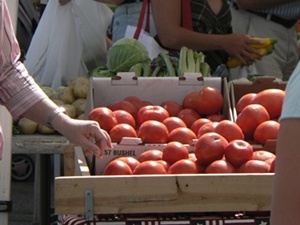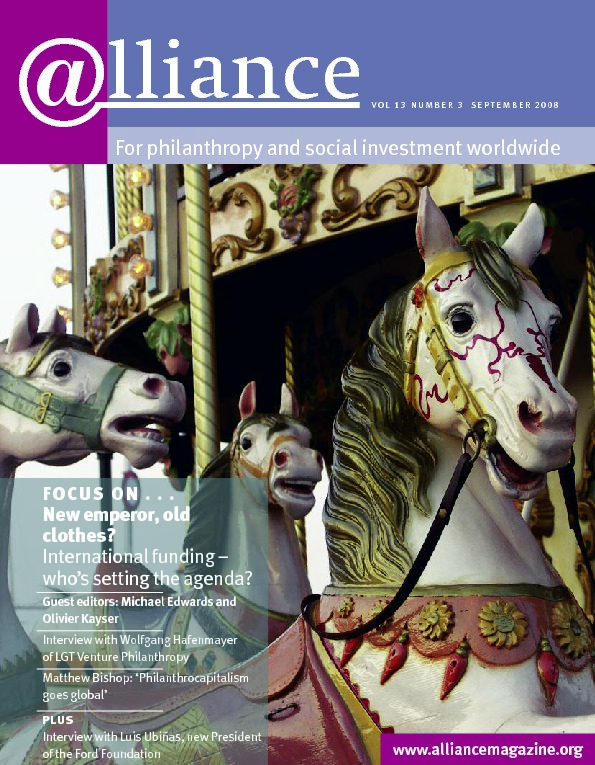 The global financial crisis has shaken our faith in markets. Wall Street, the City of London and other financial centres asked governments for complete freedom in the capital markets. They claimed it would create value for society. Instead, it has destroyed value, and lives. This begs a question: where does that leave those of us who call for philanthropy to act more like a market? If markets fail the private sector, why should they work for civil society?
The global financial crisis has shaken our faith in markets. Wall Street, the City of London and other financial centres asked governments for complete freedom in the capital markets. They claimed it would create value for society. Instead, it has destroyed value, and lives. This begs a question: where does that leave those of us who call for philanthropy to act more like a market? If markets fail the private sector, why should they work for civil society?
In fact, the financial crisis makes it all the more urgent to build a smarter, more open infrastructure that enables donors to make good philanthropic choices. The financial crisis has brought with it urgent need: lost jobs, increased poverty, and distraction from critical environmental issues. It has also brought a reduction in available resources – from both government and private donors. It has never been more important to help funders make good decisions and reward the highest-performing non-profits.
The first image that comes to many people’s minds when they hear the word ‘market’ is the floor of the New York Stock Exchange: frantic traders yelling into phones, countless monitors streaming arcane financial data, a floor strewn with scraps of reports and analysis.
I would like to offer an alternative image: a community farmers’ market. At a farmers’ market there are buyers in search of the perfect plum or a great deal on dates. There are sellers, fresh from the fields, offering boxes of vegetables, flowers or nuts. The buyers walk around, sample the food, haggle over price with the sellers. We in the non-profit sector would be wise to learn a few lessons from these markets.
 First, and most critically, farmers’ markets offer open information. Buyers can sample a plum at one stall, and then go to the next and compare. Donors, by contrast, do not have easy access to meaningful information about whether most non-profits are doing a good job. It is even more difficult to compare one organization to the next.
First, and most critically, farmers’ markets offer open information. Buyers can sample a plum at one stall, and then go to the next and compare. Donors, by contrast, do not have easy access to meaningful information about whether most non-profits are doing a good job. It is even more difficult to compare one organization to the next.
Second, buyers at farmers’ markets are focused on finding value for money. Every buyer goes in and tries to get as much good food for their money as they can. Some sellers offer better deals (more high-quality oranges per dollar) and the buyers flock to those stalls. Non-profit marketing materials are full of anecdotes – we have this one really good orange! – but do not generally give a meaningful sense of scale or proportion. Stories and relationships are critical; they help place work in a human, narrative context. But those stories are far more meaningful when paired with data.
Third, farmers’ markets offer simple, intuitive infrastructure that enables smart, safe transactions. Stalls delineate one seller from another and protect everyone from the rain. Market organizers pick times that the market will be open and advertise those times. Trash cans offer a way to get rid of rotten vegetables and recycling bins capture bottles and boxes. Organizations like Guidestar, New Philanthropy Capital and GlobalGiving have begun to build this infrastructure for civil society. But we have a way to go until it is strong, integrated, and truly aligned towards maximizing social and environmental impact. Moreover, donors, especially large foundations, must be willing to pay for their share of that infrastructure.
Finally, farmers’ markets offer a culture of frank friendliness. If a customer likes one seller’s pecans better than another’s, they will say it. But they will say it with a smile and a nod. Freedom of choice and opportunity can lead to honesty. The harsh realities of fundraising and the great demands on donors too often breed a culture of mistrust and obfuscation. The people, ecosystems and ideals served by our work deserve nothing less than an honest conversation about performance.
It goes without saying that the financial services sector also has a lot to learn from a community farmers’ market. Mortgage-backed securities were far from transparent; the credit default swaps market was dominated by speculation, not value creation; and, of course, the Bernard Madoff scandal offers a case of outright fraud.
So let us not allow the failings of Wall Street and the City of London to distract us from the authentic lessons offered by a good, old-fashioned farmers’ market – lessons civil society should adapt to the 21st century needs of donors, non-profits, and society as a whole.
Jacob Harold is Philanthropy Program Officer at the Hewlett Foundation. Email JHarold@hewlett.org


Comments (0)